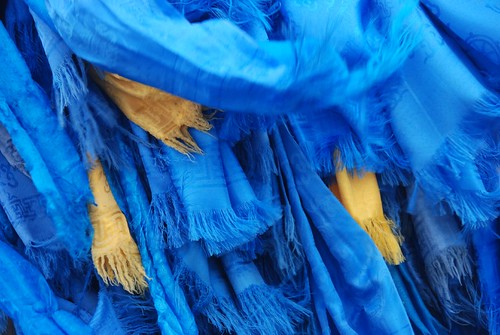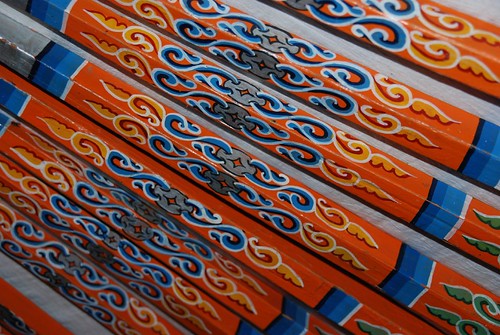Sep '0921
While in China, we talked about “Chinglish”, the Chinese English that sometimes is a little bit hard to understand and can be very funny sometimes. We already published a fine example of English translation “free style” and while going through our pictures recently, we found a few more examples, that we really think deserve to be shown to the world as they are highly intriguing, creative and most of the time hilarious. 

Poor Grass! Luckily they have a nice sign to protect them! 
The picture below (sorry for the quality) definitely shows one of the finest examples of Chinglish we encountered, a restaurant named “Hong Kong succeeds the sign powder gruel aristocratic family” at Guilin. We think that even Google would have translated this better!! But then, in China access to Google is forbidden. That maybe explains some things. 

No idea what those words all together mean!
And thinking about it, we are actually quite happy that they don’t have any access to translator-services like Google, if not, we would not have been seeing the translation on the following picture, seen on a menu of a restaurant in Chengdu:

Unfortunately they ran out of “Strange Flavor Noodles” so we didn’t get a chance to try them. Too bad! 
Vera & Jean-Christophe
Sep '0911
While rumbling through our photo-files we found this picture, which is not of very good quality, which is probably the reason why we didn’t publish it in the first place (it looks like some ISO-problem, due to bad settings – or better: not verified settings – definitely a sure indication of who took this picture

) but it sure deserves a place within “Picture in the Picture” where “quality doesn’t matter, but the story behind the picture does”.

Anybody still has a bike he needs transport for?
So this is a sure example of something that is very common in South-East Asia: overloading! And this is the proof, that they not only like to overload buses (yeah, yeah, 50 seats, but 120 people, what’s the problem sitting on a bag of rice for 12 hours???) but also mini-vans, cars and basically any means of transport.
So anyone still interested in transporting his/her bike? There is still a loooooooot of space left! 
Vera & Jean-Christophe
Jun '0920
While travelling in Mongolia, we noted the presence of blue silk cloths hanging everywhere: in temples, around people’s neck, along the dirt tracks (speaking of roads here would be highly exaggerating) attached to stone pyramids and even in the Mongolian state emblem. The blue silk cloth is known as hadag it has an important meaning for the Mongols both in its use and by its colour.

Read More »
May '0905
In most countries we travelled we had a lot of laughter with the local population. The Lao and Burmese always seem to be in a good mood, we had a lot of fun negotiating with Thai tuc-tuc drivers and we remember laughing a lot with Russians in the Transsiberian railroad who at all price wanted to talk to us even if they often didn’t speak a word of English. But there is one folk that marked us specifically with their humour, an extremely not very expanded in Europe (What’s zis Inglîsh? We’d almoz zink zis articul ‘as been ritten by JaiCéé!!!  ). So what I meant to say is: There is one country where the people marked us especially with their humour. A humour that is a very dry one, not very expanded in Europe, except maybe in Great-Britain: the Australian one!
). So what I meant to say is: There is one country where the people marked us especially with their humour. A humour that is a very dry one, not very expanded in Europe, except maybe in Great-Britain: the Australian one! 
The Australians have this no-nonsense attitude, which makes they greet everybody with “Hey mate!”. And when we say everybody, we mean everybody: from young to old, no matter the social class. We clearly remember one evening when a rather old lady greeted Jean-Christophe with “Hey mate!” and he got a little bit panicked about how to greet back, because, let’s face it, in Europe it would never ever come to our mind to greet someone the age of our grandparents with “Hey mate!” let alone that this person would greet us like that in return.  But the Australians they do. No problem at all!
But the Australians they do. No problem at all!
Below are some other examples of real Australian humour, there is absolutely nothing to add to this. 

Seen in the Sydney Harbour

Seen at a market stall selling delicious chocolate

Vera & Jean-Christophe
May '0901
Motivated by both Melanies (yep, one from Germany and the other one living in Guadeloupe) we decided that it was maybe time to revive this picture in the picture category again. After all it is nice even for us to travel with help from our pics and we do realize that we really have a story to tell for each of them.
Today we want to talk a little bit about yurts. During our time in Mongolia we decided to go on a tour to see the country. Mongolia is vast, there is only one official road connecting the current capital, Ulan Bator with the old capital, Karakorum. All the rest of the roads are “dust tracks” that are impossible to get along on, except if you have a sturdy old Russian jeep and a driver who for some reason knows that if he meets this one particular bush that is opposite this one mountain and with the sun setting over this one sandhill, that he has to make a 90 degrees turn to the right. In other words: it’s impossible to know where to go as everything resembles; all the bushes look the same, as do the mountains and the sandhills, but those drivers “just feel” where to go and during our 12-day trip we never got lost and always found some yurts to sleep (although, to make it even more difficult, Mongolian people are nomads, so those yurts move all the time too).

Beautiful decoration of the wooden lattice inside a Mongolian gher
Read More »
Feb '0901
Arrogance:
“The act or habit of arrogating, or making undue claims in an overbearing manner; that species of pride which consists in exorbitant claims of rank, dignity, estimation, or power, or which exalts the worth or importance of the person to an undue degree; proud contempt of others; lordliness; haughtiness; self-assumption; presumption.”
Source: Wiktionary

Arrogant advertisement with potential

Vera & Jean-Christophe
For a related article on Chinglish, see our first impressions on China.
Jan '0929
The picture below was taken at a bus station somewhere in Laos, where we sat for a while in order for the bus to be unloaded from its tons of kilos of rice and then reloaded with tons of other stuff. The guy at the picture made some nice entertainment though, because he had found a very interesting way of fixing a TV. It should be noted that the TV was playing tricks on him in that, if he would stand directly next to it, it would work. If he would then climb down the staircase and walk away, it would start “snowing” again until the guy climbed up the staircase and put himself next to it. After several trials, the guy decided he would just stay and stand next to the TV as this was obviously the only logical way to make it work. 

As long as the guy stood there, the TV would work
Vera & Jean-Christophe
Jan '0924
Of course Nepal was fantastic: the constant beautiful view on the mountains, the incredible Tibetan culture and our funny guide made that this is for us a country we will not forget soon. Nepal is, as many other developing countries, dependent on foreign tourism, which brings a lot of work for the local population.
But there is also a downside to all this: tourism generates a lot of trash. 

The downside of tourism
Read More »
















